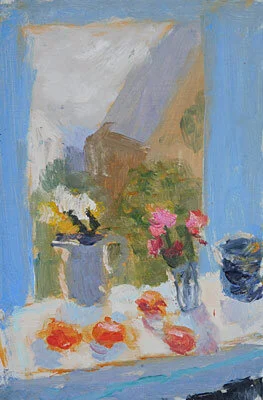The Rocking Chair by the Sea - 100 x 100 cm - Oil on Canvas
The Toy Boat and Pink Glass - 61 x 51 cm - Oil on Canvas
The Orange Cloth, Open Book and Yellow Apples - 61 x 76 cm - Oil on Canvas
Dazzling Day, Portscatho - 76 x 101 cm - Oil on Canvas
Table Talk - 61 x 76 cm - Oil on Canvas
Upstairs Mirror and Three Jugs - 61 x 76 cm - Oil on Canvas
May Blossom and Green Glass - 15 x 20 cm - Oil on Board
Clementines and Lemons - 35 x 25 cm - Oil on Canvas
Saucer and Teacup - 15 x 20 cm - Oil on Board
First Roses and a Red and White Checked Cloth - 51 x 41 cm - Oil on Canvas
The Indigo Checked Cloth, Portscatho - 61 x 51 cm - Oil on Canvas
Oranges in the Studio - 35 x 25 cm - Oil on Canvas
Two Tables of Flowers, St Ives Studio - 61 x 42 cm - Oil on Board
St Ives School of Painting Window - 30 x 20 cm - Oil on Board
Bright Orange Cloth in St Ives School of Painting Window - 30 x 20 cm - Oil on Board
Boat Leaving Newlyn Harbour - 35 x 25 cm - Oil on Canvas
The Red Cloth, with a bit of Fushsia - 20 x 30 cm - Oil on Board
The Emerald Vase - 15 x 20 cm - Oil on Board
The Blue Chair and Camellias - 35 x 25 cm - Oil on Canvas
Pink Shadows - 82 x 61 cm - Oil on Board
We moved a great deal when we were growing up because of my father’s work, Libya, Colombia, Norway, Kuwait, Buckinghamshire.
There were two constants; coming back to family in Cornwall, and my mother’s ability to make anywhere into a home.
This often centred round the kitchen table, which was made into a daily still life. There were deep red and yellow rectangular Provençale place mats, with black napkins and pink plates, or a few quinces on an oval plate and the table with a pale blue damask cloth. In fact, still lives were made on any table – kitchen, coffee or side table, with flowers, Arabic coffee pots and glasses and coloured candles and cloths, in other words, a visual feast.
Whilst studying at Camberwell Art School, we were instructed to explore form in light in space, but I did not particularly choose still life. It was only after I had left home and had married that I was drawn to this motif. Maybe I was drawn back to it because it had been a joyful, still centre at the heart of a changing world.
The other role of the table was as a surface for my mother to do her watercolours. Painting was as usual an activity as any to her, and I remember watching her tip the paper up to make the paint move in the chosen direction.
There was a synergy between making a home, making something paintable and working at the table that seemed so natural it was infectious.



















